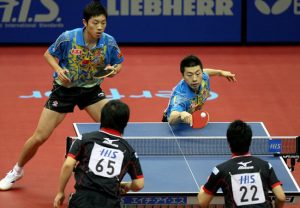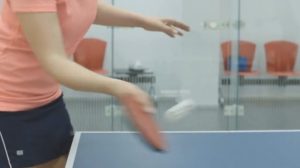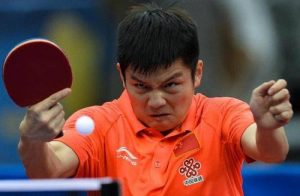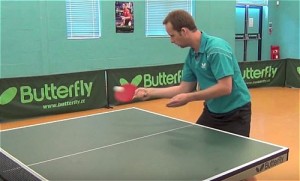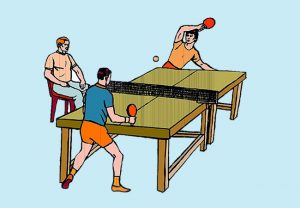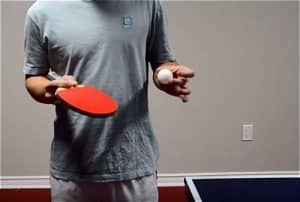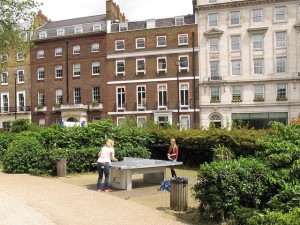Getting your footwork right is a compulsory table tennis technique you should master if you are serious about improving your game.
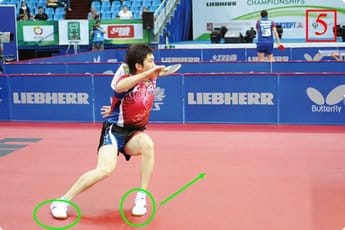
When you start playing ping pong, the first thing you need to do is put on some footwork training. Footwork is essential because the proper foot movement will have well coordination with your serves and strokes.
If you ignore footwork, then without good conformity of your leg movement with your strokes, you will not play the game well, and you will never get a good and accurate shot to beat your opponents. Therefore, to master the basic table tennis techniques, you need to practice footwork.
You need to be able to position yourself well during any game for you to have reasonable control to keep up with your opponent’s pace and speed.
The modern table tennis game is full of attacking players, so the ability to return offensive and aggressive shots will depend mainly on how good you are with your footwork.
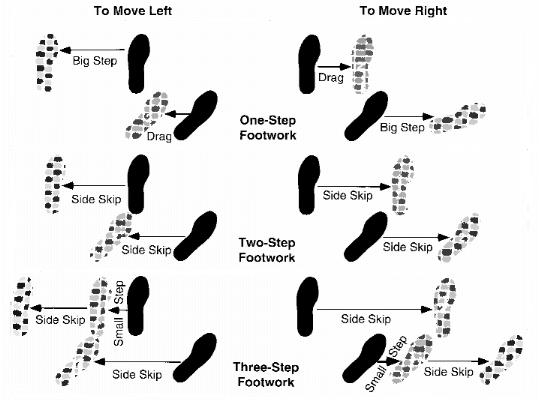
Table of Contents
ToggleThe Ready Stance in Table Tennis Technique
When you first practice the game, you will need to understand the ready stance well. The ping pong game’s ready stance is known as the ready position in which a player takes on in advance of receiving any shot or serve from the opponent. It is where the player’s movement starts a game with their stance.
The correct stance also makes you stay in a ready position for flexible movement to receive the ball that your opponent serves. When you can grasp the ready stance well, it is also possible for you to effectively control your footwork.
The Basic Stance….
1) Your must slightly bend your body with your arms placed forward.
2) The hand holding the racket must be bent at the elbow to a 90 degrees angle.
3) The posture of your ankles and knees when you are waiting for your opponent’s serve should be slightly bent while the weight needs to be on the balls of your feet.
4) Assuming you are a right-hand player, you should slightly move your elbow to the left of the middle of the table with your left foot a little bit forward.
5) Always stand a little bit close to the table but not too close with your arm close to your body.
Having Great Movement With Right Footwork
Many players have good table tennis strokes, but they cannot execute them well as their movement is not good. Let’s discuss something on how to improve your overall footwork to improve your skill and play a better game.

Apart from the basic stance in table tennis technique, you need to develop good hand and eye coordination to control your footwork.
When you are in a good ready position, and you have good hand and eye coordination, your opponent cannot be able to catch you unaware with an unexpected shot that can easily take you off-balance.
Your opponent can use your footwork against you if he or she can predict your movement.
You can always practice your footwork with your training partner. However, if your training partner is not around, it is still possible for you to practice. How? Well, with the advancing of technology in today’s world, you can practice your footwork with the aid of a table tennis robot. There are many ping pong robots available at the market, and you can choose one to practice by using the robot. You may master your footwork in a short period if you do it right.
The idea is to practice sideways movement in both directions, returning shots with both your forehand and backhand and always move back to your ready position after you return any shot.
Having Great Movement With Right Footwork
Many players are having good table tennis strokes but they cannot execute them well as their movement is not good. Well, let’s discuss something on how to improve your overall footwork so that you can improve your skill and play a better game.
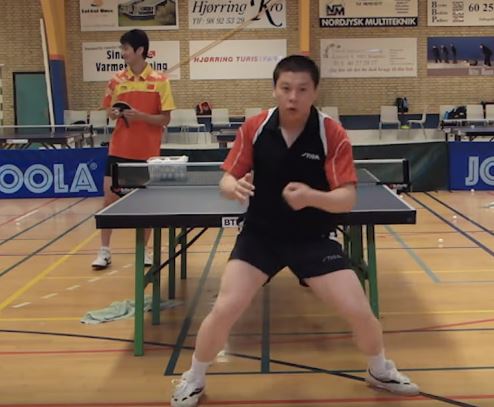
When playing table tennis footwork and getting into position before the ball comes to you is crucial. I will give you some steps that helped me and my students to improve a lot, only with 2-3 training sessions.
1. Always play as if the ball will come back no matter what. This way you will always get back to your ready position after you have finished your stroke/serve/receive.
2. Open your legs 2 X shoulder width (this is not a general rule for everyone find the opening that suits you) approximately and sit on an imaginary chair bending your knees and then stand on your toes.
Your core must lean forward so that your whole (at least most of it)bodyweight will be controlled by your quadriceps. This way you can start jumping around WITH BALANCE (balance is very important so that you won’t be out of position after a stroke).
Check these videos for more information:
And also don’t miss out on all of these videos named “Chinese Footwork part 1,2,3,4,5,6”.
Start with Simple Exercise
If you want to improve, choose a simple exercise, 2 FH, for example (one in the middle and one in your wide FH), and try to execute 10 perfect FH topspins. Then go for 15, 20, 30, and so on. Another good exercise is to receive on your short FH side and then go back fast, waiting either for a BH or FH loop and then play the rally or execute the previous exercise.
Remember, if you don’t keep the ball on the table with perfectly executed footwork, you will never improve. It would help if you were focused on your weight being on your quadriceps and use little jumps on your toes. Executing the stroke is easy. Executing 15 perfect strokes with good footwork is a much more challenging task.
Falkenberg Drill
The 3 and 4 Ball Falkenberg Drill will help develop your Footwork, Balance, and Movement to the Ball to Return. There is an excellent video of Danish Player Mie Skov doing this drill with her coach, and you can watch it on YouTube to get an idea of how and why this works so well. Google Mie Skov Falkenberg Drill, and it will come up.
You can set this drill up on a table tennis robot or have a coach or training partner feed you Multi-Ball as in the Video.
For 3-Ball Falkenberg – these are all against Tospsin Balls and would be a good starting point for developing your footwork.
Ball 1 Backhand vs. a Topspin Ball, Ball 2 Forehand vs. a Top Spin Ball – Step Around and hit with your Forehand Drive, Ball 3 vs. a Tops Spin Ball – sidestep and hit with your Forehand Drive. Back to ready position for the next Backhand. Do for One Minute and Drink water, and rest in-between for a total of 3 Drills starting.
Later after you are used to doing the 3 ball Falkenberg drill, you can try this one next.
The 4-Ball Falkenberg adds a Backspin Ball at Ball Number 3, and it goes like this.
Ball 1 – BH vs Topspin, Ball 2 – FH vs Topspin, Ball 3 FH Slow-Loop vs Backspin. Ball 4 – FH Smash vs Topspin.
Ball 1 – hit with your Backhand, Ball 2 – Step Around and hit with your Forehand Drive. Ball 3 is against a BACKSPIN ball. Sidestep to the Ball and Brush UP on the Ball to Loop-Spin it over the Net. Ball 4 is Top Spin so use your Forehand Drive to Smash the Ball for a point. Back to the ready position for the next Backhand Ball #1.
This drill teaches you how to move between balls and change your racket angle between Balls 3 and Ball 4. For Ball 3, you hit with a Slow Loop – you need to use a 90% Racket Angle to Brush UP on the ball to create many Top Spins to get the ball over the Net.
The Next Ball – Ball #4 comes back with Top Spin, and you need to be ready to kill this ball. So change your racket angle down to 45% and Hit Forward and Up for a Forehand Drive/Smash to kill the point. This drill simulates a game volley point-ending situation well.
Remember to Keep your Center of Gravity LOW. Bend your knees and Legs, and remember to keep your balance as you move back and forth to the ball. It takes a few times, but you will get better after each drill session over a few weeks and months.
For both drill practices, be sure to start slow and easy and don’t overdo it. A little goes a long way with these drills towards improving your footwork. So 1 minute each with 3 drills total is a good starting point.
Doing this will have you breathing hard at first, and your legs will feel it afterward, too. Just be sure not to overdo it at first, and take a break in between drills to have water and catch your breath. So please give this a try. They are a lot of fun too.
Classic Coached Footwork
Classic coached footwork is small skipping steps.
Feet just a bit wider than shoulders.
For RH players:- If moving to the right, move L foot first. If moving to the left, move R foot first. i.e., the trailing foot first.
A technique called the ‘heavy left foot’ is good for attacking balls from the FH side. R move R foot ( leading foot ) first, rotate hips, plant L foot heavy, execute shot & then R foot comes forward to stop hip rotation.
R foot should end up behind L foot with feet apart at shoulder width. See Richard Prause & Dirk Wagner teaching this technique to William Herzell on ttEDGE video clips.
Of course, underpinning all of this is to ‘expect and move early.’ Read the opponent’s body language and bat and try to anticipate the shot he intends to make before he hits the ball. Not Easy, instinctive.
Ways to Improve Footwork Practice
Lately, I have been wondering how to increase my footwork. I know that a lot of practice is essential, but I wondered what kind of exercises would be helpful. I have seen some matches which inspired me to train lately. Especially when you look at the footwork of world-class players is impressive.
Which makes me wonder what exercises are helpful to increase my footwork. I thought of exercises in which one places the ball in a pattern all over the table, and the other has to keep on attacking.
I started to ask around for experts to tell me their favorite exercises, with or without a table and partner, and take their sharing experience to increase my footwork skills.
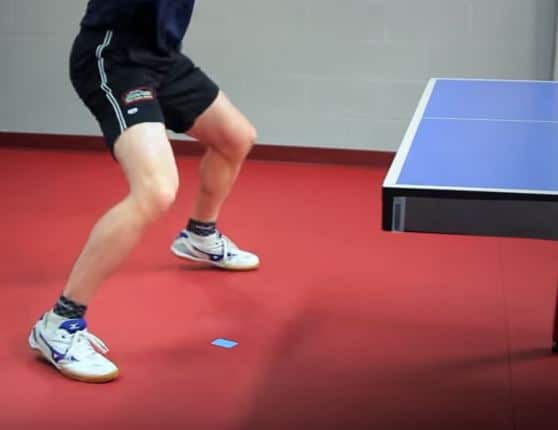
Shadow Play
One skill I found instrumental is a shadow play. It is a good thing and gives me a clear idea of where to place my feet.
Secondary movement, when I have to try play forehands mainly and if I found I have stepped too short make that next movement. Jumping is also suitable as I found it gives me a more robust push-off when out of position.
When I am not training at table tennis, I will try to do some squats. They involve almost all the muscle groups in my legs, and I will have much better explosiveness in my footwork. I have observed noticeable improvement even after a short time.
How Useful is Shadow Play?
Shadow play is a training method used to repeat technical strokes without a table, ball, or training partner. Essentially you are just going through the motions. Some players and coaches might downplay shadow practice as an ineffective training method, and this position is not correct. Shadow play can be a highly effective addition to your training regime and is sometimes just as beneficial as an ordinary training session.
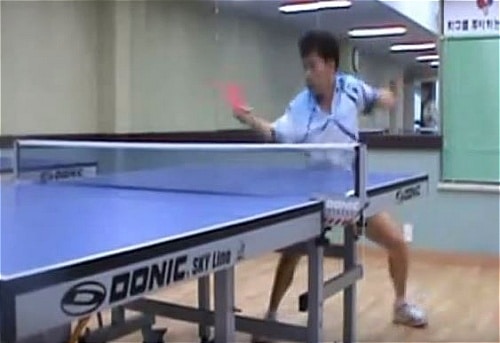
Adding just a small amount of shadow practice to your training can solidify your technical consistency and drill the technique in. Shadow practice has also been shown to be effective in other sports like tennis and boxing, commonly used.
Shadow play can be instrumental if you don’t have a training partner or somewhere to play table tennis, and you can do it at home. You can do it by yourself or in your training groups, or as seen above as part of a program. Above is the Aerobic Table Tennis program, which combines shadow practice, table tennis, and fitness to encourage more girls to participate in table tennis.
So despite the skeptics, I encourage you to utilize shadow play, even as a minor part of your training, to get those technical strokes set in stone 🙂
Consistency Is The Key
For those looking for a way to improve their footwork, this is the practice you can follow. Be careful and execute this footwork when you don’t practice in table tennis, or at least 5-6 hours before or after your training. Make sure you are not tired so that your body takes full advantage of the exercise.
Now when training in table tennis, you should try multi-ball or shadow play. When doing multi-ball, execute fast-paced topspins all over the table at your full speed for 30 seconds and take 10-20 seconds to break. Repeat until it exhausts you. After the first two to three weeks of multi-ball and squats, you will reach a whole different level 🙂
How to Start?
Start by building strength up in your legs—squats, cycling, jogging, some weights, etc. Once you have improved strength, maintain it and work on increasing balance and agility with routines involving sidestepping, shuttle runs, etc.
Agility ladders are useful in this phase. Finally, once you have improved your strength and agility, combine the 2 and work on increasing your power with jump squats, sidestep jumps, star jumps, etc. Integrate this into your practice sessions, maybe 10-15 minutes in the end and as part of your strength and conditioning program.
As mentioned before, shadow play is excellent for footwork techniques. Do it at the end of the table and concentrate on your feet. Work your way through the movements slowly first and build up the pace.
Focus on where your weight is throughout each movement and always try to recover balance evenly across both feet as quickly as possible after each shot. Good footwork is like learning contemporary dance.
I have always wondered if a few dancing lessons would help a player with their footwork too. It might be worth a try.
Differentiating Short and Long Footwork Training
Footwork is a big part of table tennis, and such are written about often and in detail. Today I will take a moment to split footwork into 2 distinct groups, short footwork and long footwork. Both are significantly important in table tennis and require different forms of drills to develop, and while a player may be efficient at one, they may require improvements in the other.
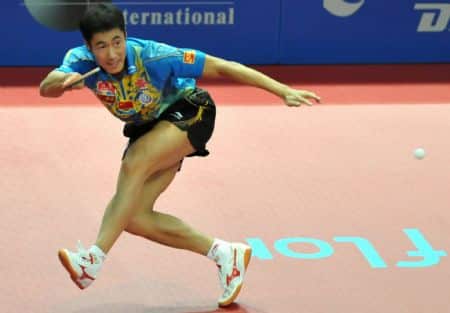
Short Footwork:
Short footwork is the small movements required continuously to recover and be in position for the ball, also called small footwork. These movements often center on shuffling and short steps but are incredibly important for maintaining body position and balance and, of course, not getting caught off guard.
How to Identify a Problem with Short Footwork:
Often it is body shots or a slight discrepancy in timing or position which will identify that a player is not automatically making small footwork adjustments. Usually, a player may subconsciously be lazy and choose instead to reach an extra inch or two to make a less efficient shot.
The ball goes back on the table, and so the player automatically assumes the shot was a success. However, it is essential to note that small footwork can differentiate between a 50% shot and a 100% shot as small as that gap in the movement may be.
Short Footwork Drills:
Short footwork drills should focus on small changes in body position. A good exercise for this is the multiple point forehand where the controller starts with the first ball wide on the forehand and gradually shifts the placement across the table to the backhand corner over as many strokes as they can manage (5-8 is normal).
It encourages small changes in placement but the necessity for a movement, as minor as it may be, for each ball.
Middle balling is also another good exercise, controlling balls to the middle third of the table. A player is forced to continually choose whether a backhand or forehand is the most efficient shot to play. Of course, the target is centered on the body, so movement is vital. Both of the above drills can be fed multi-ball or with a partner.
There are, of course, a considerable number of drills that focus on small footwork movements. The above 2 are just a couple of my favorites.
Long Footwork:
Long footwork focuses on larger movements and balls that are further away from the body, particularly wide-angle balls and fast recovery. What is often notable is that the recovery to backhand after a wide-angle forehand can often be an area that requires a considerable amount of training to become efficient.
How to Identify Problems with Long Footwork:
It is simple to identify; a player is usually not making the more comprehensive angle balls or is moving in time but not in the correct body position where they have a stable center of gravity to work with.
You can also see the player may not recover fast enough from the wide ball, as mentioned above, and this is a clear sign that more focused practice is required.
Long Footwork Drills:
Lazy Falkenberg is a drill that helps, despite the name. Unlike the standard drill, the Lazy Falkenberg is a ball selection drill where a player hits backhands until they choose the pivot forehand.
Once the player has hit the pivot ball, the controller hits the wide forehand and then returns the ball to the backhand as with the regular drill. Start with leniency and then try to increase the wide forehand ball’s width to press the distance.
Another intense exercise is 2 point forehand. You can start on the middle line, forehand line or middle forehand, middle backhand and gradually increase the distance between the two shots. Mastery of long footwork is when you can consistently hit forehands from each wide corner continuously as we often see players like Xu Xin or Wang Liqin doing.
So another essential pointer on footwork, it might seem obvious to you, but it is essential to distinguish the difference between short and long footwork so you can work on both. Short footwork focuses on burst speed, while long footwork is based on explosive leg power, so physically, they both require different types of strength.
Related post:

Warren Davies
Hi, I’m Warren Davies, a table tennis addict who loves sharing tips, reviews, and everything you need to level up your game. I’ve spent years playing, testing gear, and geeking out over the sport, and I’m here to make things simple and fun for players of all levels. When I’m not writing, you’ll probably find me perfecting my forehand or trying out the latest paddle.

